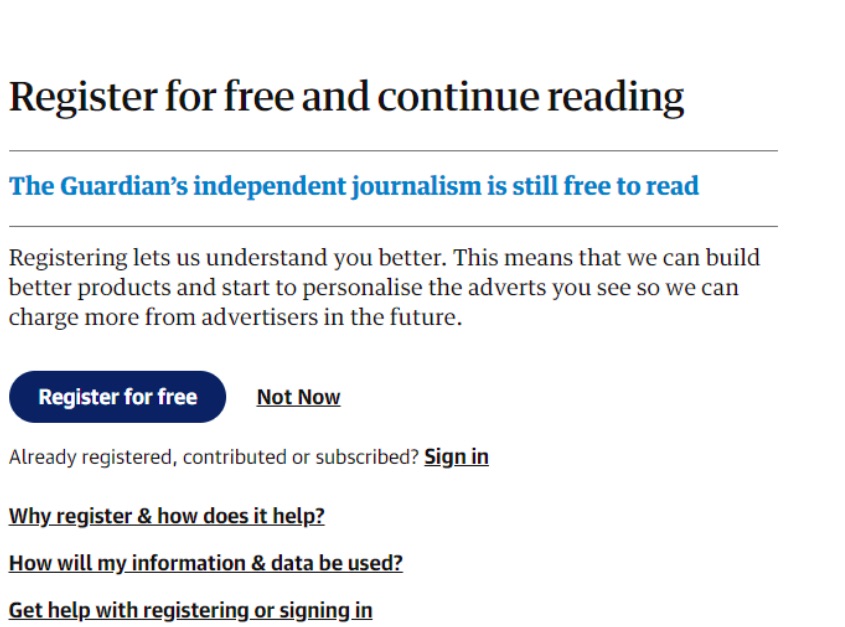Connect with execs from The New York Times, TIME, Dotdash Meredith and many more

To build out its first-party data strategy, The Guardian is asking people to sign in.
In December, The Guardian began testing a registration wall with a select group of its audience, according to a post from chief product officer Caspar Llewellyn Smith. The goal: Improve its products and tailor more relevant ads for readers to ensure the publisher’s financial stability.
“Asking readers to sign in provides us with more information that we can use to personalize our approach in asking for support, to serve advertising (with readers’ consent) and to create a better user experience,” the post said.
Clicking on an article, readers see a message asking them to register for free to keep reading, although registration is not compulsory and readers can click a “Not Now” tab. In April, the publisher started running a similar test, piquing the interest of media onlookers. Signed-in users get perks like being able to leave comments, access to editorial newsletters and can opt-in to receive discounts or special offers. This also gives valuable insight into content preferences, for instance, The Guardian’s support messages reference how many articles you have read that month.
“It’s a good move,” said senior analyst at Enders, Alice Pickthall. “Registration is part of the funnel to growing reader engagement and donations while improving advertising quality and targeting so the benefit will be twofold to both strands of revenue.”

Registration walls beef up first-party data, which power subscriber acquisition, retention and enhance ad products. More publishers, like The New York Times, Hearst Newspapers and Tribune Publishing, have given registration walls another look over the last year. Publishers get visibility of content preferences and can tailor products and content, increasing subscriber acquisition. The subscriber conversion rate is 10 times higher for known users compared to anonymous users, according to subscription platform Piano.
First-party data is also the power behind retention. “You can’t do good churn analysis without first-party data,” said media analyst Thomas Beakdal. Nordic publisher Schibsted was able to increase the number of people who didn’t churn by 10 percentage points because it could map out people’s cancelation journeys through its first-party data.
The other goal in building out valuable publisher first-party data is to gird against the dying third-party cookie, a push publishers like The Washington Post, Vox and Business Insider are also making. A registration wall, where readers enter details like email, address and title, forms more robust audience segments that advertisers can target, and increases the premium it can charge for ads. Last week, not yet a year after introducing its registration wall, The New York Times said it was swearing off all third-party advertising data.
The Guardian maintains a strong stance that its journalism remains free and open to all, especially during a pandemic when access to accurate information is fundamentally a civic right. The move is not a paywall or the first steps towards one.
Now is a time of high traffic and low ad revenues. Globally, The Guardian’s unique browser numbers reached 366 million in March, doubling from February’s record of 191 million, according to internal figures. The number of both regular daily and weekly visitors have increased by a third. Readers clocked up 2.17 billion page views in March, an increase of over 750 million on the previous record set in October 2019.
Traffic to news sites is beginning to taper but remains higher than pre-pandemic. In April in the U.K., The Guardian had 34.7 million monthly unique users, down from 35.7 million in March, according to Comscore. That’s a big leap from February, where it had 25.6 million unique readers.
That’s coupled with publishers experiencing a 65% decrease in programmatic revenues, due to a cocktail of low CPMs as swathes of advertisers stop spending on campaigns and brands block ads on coronavirus content.
While advertising revenue is important, The Guardian is on the road of reaching 2 million paying supporters by 2022.
More in Media

Three publishers’ workforce diversity reports show DEI efforts remain sluggish
Overall, staff diversity at The New York Times, Hearst and Condé Nast has either marginally improved or stalled in 2024, according to their annual workforce diversity data this year.

Retail media meets publishing: News UK, Future and Ocado tap clean room tech for smarter data targeting
News UK, The Independent, Immediate Media and Future are teaming up with retail media network Ocado to test clean room-powered data matching.

From sidelines to spotlight: Esports events are putting creators center stage
Esports events’ embrace of content creators reflects advertisers’ changing priorities across both gaming and the wider culture. In the past, marketers viewed esports as one of the best ways to reach gamers. In 2025, brands are instead prioritizing creators in their outreach to audiences across demographics and interest areas, including gaming.








